Guidelines for Optical Symmetry in Hearts And Arrows
While some sort of standardization exists, there are still a lot of cutters who are producing under par diamonds and trying to pass them off as Hearts and Arrows stones. Here are some basic guidelines that you can use to check whether your chosen diamond has good optical symmetry.
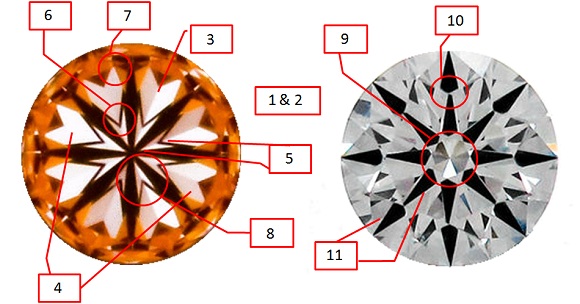
- In a true Hearts and Arrows diamond, there should be 8 regularly shaped hearts and 8 regularly shaped arrows. The absence of all or any hearts or arrows is not permitted.
- Both hearts and arrows should have identical intensity. That is, one heart’s presence should be just as pronounced as the other’s.
- Ideally speaking, the coloration of the hearts is not permitted. While this feature is relatively minor, you should see a single color tone instead of 2 different shades of colors.
- Both hearts and v-tips should be symmetrical. That is, one side of the heart and the v-tip should look like a mirror image of the other side.
- The shafts around the hearts should be aligned with the points of the arrows; otherwise the two sets of shapes will not play nicely together.
- There should be a gap between every heart shape and the V-shape at their bottom. Of course, the gaps between each of the 8 hearts should be equal.
- There should be little to no variation in shoulder width in the hearts, and the shoulders should not be pointed either.
- The V-shape pattern formed by the V-shapes at the bottoms of the hearts should be symmetrical.
- The table reflection between the ends of the arrow shafts should be a regular shape and have a medium diameter.
- Each arrow head and the shaft should be correctly aligned.
- The size of the arrow shafts and pointed tips should be uniform.
What Is An Acceptable Standard For The 8 Hearts And 8 Arrows?
In reality, a perfectly cut diamond that conforms 100% to all these guidelines rarely exists. Even the top 0.1% of the round brilliant cuts in the market would exhibit some form of minor variations.
These minute variations are acceptable as long as the diamond conforms to the overall integrity of the guidelines listed above.

Too Many Penalties – Reject This Stone
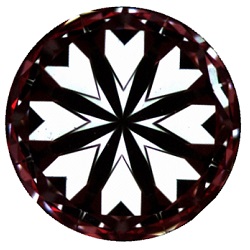
Minor Defects – Passable
Also, taking a great picture or viewing the hearts and arrows patterning isn’t a straightforward process. It does require some practice especially if you had no prior experience.
Any slight tilt of the diamond (even by as little as 0.5 degrees) or misalignment of your eye would cause the patterning to be slightly skewed. So, bear this in mind when you are physically examining diamonds in stores.
Analysis of Hearts & Arrows Diamonds in Real Life
Let’s take a look at some hearts and arrows diamonds and analyze the precision of their optical symmetry. Below, I’ve randomly selected two diamonds from James Allen’s True Hearts selection.
I’ve extracted their hearts and arrows images for your convenience below and if you want to look at full details, feel free to click on the links to view their respective video listings.
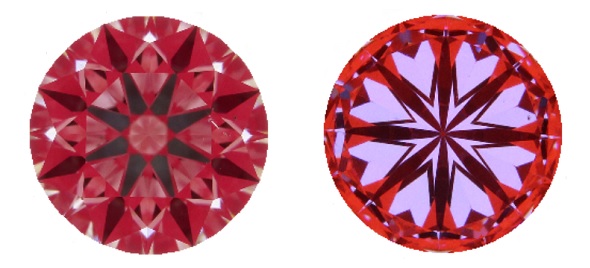
Diamond #1 – 0.70ct F color VS2 GIA certified round brilliant cut.
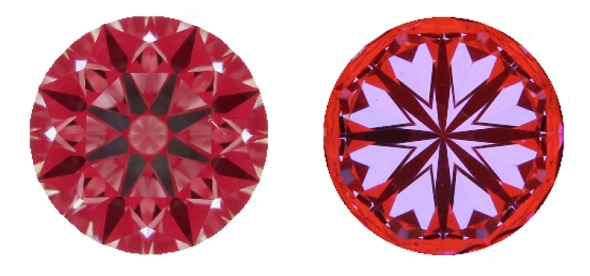
Diamond #2 – 0.57ct E color VS1 GIA certified round brilliant cut.
I want you to look at the hearts and arrows patterning for both diamonds. Using the guidelines I had earlier stated, which diamond do you think had the better cut precision?
If you said diamond #2, you are right. The first diamond has some inconsistencies in the spacings between the V and hearts. Strictly speaking, I would not consider diamond #1 to qualify as a hearts and arrows diamond.
Example of a Poor Arrows Patterning
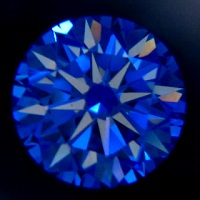
2. Shaft thickness and size variations.
3. Irregularly formed center.
4. Pointed heads do not reach the edge.
5. Missing arrow heads.
Example of a Poor Hearts Pattern

2. Different sizes of the individual hearts.
3. Pointed shoulders at 2, 3 ,4 o’clock.
4. V-shaped tips have merged together.
5. Irregular spacing of V’s and hearts.
For a more detailed read, click this link to download the guidelines used by HRD to analyze hearts and arrows patternings. While these rules may seem like a lot to pay attention to, it rightfully deserves your attention.
That’s because when you are buying super ideal cut diamonds, there is a price premium placed on such diamonds. Vendors and jewelers often advertise their inventories with fanciful marketing gimmicks and loosely misuse the hearts and arrows terminology.
The onus is on you to learn what defines a super ideal cut diamond and how to suss them out. This will help you determine whether you are paying the right price for the right quality.
Related Articles
Leave A Comment

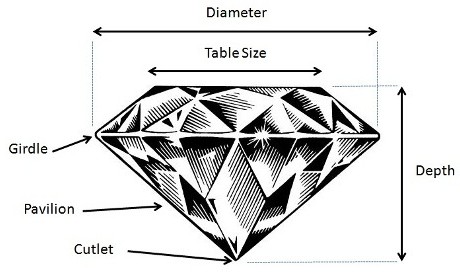
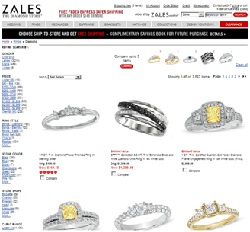

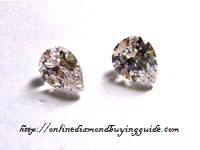









17 Comments
Can you help me buy AGS stones with triple ideal 0? How can you ensure the color grading of AGS to be as good as GIA; which is banked upon by many people? What kind of discounts should I expect? What will the differences in star facets cause in the round cut diamond patterning?
You would expect to pay a slight premium for AGS000 diamonds instead of expecting a discount for these diamonds. These stones are typically cut for top of the line optics. You can find them at these 2 vendors:
https://beyond4cs.com/reviews/brian-gavin-diamonds/
https://beyond4cs.com/reviews/whiteflash/
In general, if a diamond as lower girdle facets of 75% or less, the hearts are fatter and the distance between the Vs is lesser.
On the other hand, if a diamond has longer lower girdle facets of 80% or more, the hearts will be shaped thinner and the distance between the Vs will be further.
Hi there,
Thank you for the informative hearts and arrows diamond chart.
Would like your expertise on these two stones please?
GIA – 2216401861
GIA – 2214347764
In terms of quality is this a decent stone, being it is not the perfect diamond. My jeweler doesn’t provide hearts and arrows diagrams like those you used in the article here.
Many thanks.
J
You probably want to check against this for starters:
https://beyond4cs.com/shapes/round/ideal-proportions/
Also, there’s no way for me to tell you how well cut a diamond is based on numbers alone. You’ll need images and tangible scope data. I’ve been constantly emphasizing on the need for scope images and magnified videos/photos of the diamond instead of blinding relying on a grading report.
You want to read every single word here: https://beyond4cs.com/buying-diamonds-blind/
If your jeweler doesn’t provide tangible information about the diamond, WHY are you buying from him/her? Thee are so many other places that offer better service than this jeweler. Change your jeweler if you want to buy a truly high quality diamond.
Thanks for the thorough information Paul, GIA info is only the first step but will definitely take your advice and see in person and in detail idealscope images.
Hi, I’m looking at some diamonds they are suppose to be ideal cut round .33C VSI G, I ask to see them under a aset scope there are 7 of them 1 had green Completely around the edge , but all stones show the arrows, but none of them show hearts patterns, could this still be a ideal cut diamonds I’m not looking for it to be a super ideal cut.
Do the inclusions on the hearts patterning disqualify it as a super ideal cut diamond?
The stone isn’t cut as well as it could be. You can compare the images you have of the light performance against the reference charts here: https://beyond4cs.com/grading/aset-reference-charts/
As for your next question, the presence of inclusions on the hearts patterning or arrows patterning is NOT something that qualifies or disqualifies the diamond as a super ideal cut. Clarity and cut quality are 2 completely different things. In the example below, the diamond would pass my checks to be a true hearts and arrows diamond despite having numerous inclusions. It is a top notch cut quality diamond but that’s not to say I would buy it. The reason is simple, the inclusions aren’t eyeclean. Even though it is a hearts and arrows diamond, I want the diamond to be eyeclean as well if I were to buy it.
Hi Paul,
Thank you so much for all your work.
Could you please help me to decide between the two following diamonds?
I don’t care about the size difference, I would have like to know if I can expect one of the two to be more sparkling than the other one. I would not have expect them to be different, however, the second one seems to have less fire than the first one. Could this be due to different lights during capture? Can I expect a difference? Which one would you recommend?
https://www.jamesallen.com/mobile/loose-diamonds/round-cut/0.51-carat-d-color-vs2-clarity-excellent-cut-sku-916396
https://www.jamesallen.com/mobile/loose-diamonds/round-cut/0.51-carat-d-color-vs2-clarity-excellent-cut-sku-1925447
Many thanks for your great help!!!
Both diamonds would be on par. Personally, I would gravitate towards the first diamond.
Thanks Paul for your quick reply.
Following your advice I bought the first one. Could you please let me know why you had a preference for this one, just to understand.
Cut quality and precision. Basically, the diamond has better cut precision which can be seen on the hearts patterning and everything else I laid out on this page.
I have an ideal square diamond with an AGS report however, I want to upgrade my diamond (same type of stone and quality) and when I go in to various jewelers, they tell me that there is no such thing as an ideal square – it is either a princess or cushion cut. Is there such a thing as a square diamond? If so, why is it that these jewelers don’t know what I’m talking about (the AGS report says CC Square Brilliant for Shape and Style). I would go back to my original jeweler but it was a family run business and the father passed away a few years ago and they closed the company. Thanks for you help!
I think CC Square Brilliant is the short term for Cushion Cut Square Brilliant which is somewhat of a hybrid radiant cut diamond.
Paul I have a Lazare Kaplan GIA certed triple ex H VS2 diamond but it is mounted . Can you see hearts and arrows on a Lazare GIA triple ex. Lazare states you can on a viewer on all their stones but can you on a mounted stone. Thanks Lois
Nope you can’t. Simple logic dictates that. How would you be able to flip a diamond that is already mounted on a ring and view it through the pavilion facets? There’s no way to physically do it unless you detach and unmount the diamond first.
Hi Paul. I bought a diamond but can’t see the black arrows in any lighting. Did I buy a bad diamond? I am so stressed about this now. Can I send pictures for you to take a look?
You need to look at it in the correct lighting. Neutral, fluorescent lighting will be best for viewing contrast patterning of a diamond.